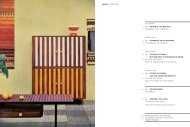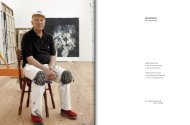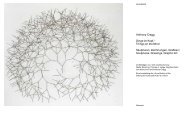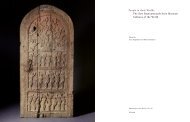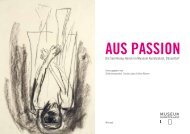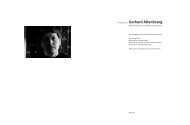Die Kunstsammlung der Deutschen Bundesbank The Art Collection ...
Die Kunstsammlung der Deutschen Bundesbank The Art Collection ...
Die Kunstsammlung der Deutschen Bundesbank The Art Collection ...
Sie wollen auch ein ePaper? Erhöhen Sie die Reichweite Ihrer Titel.
YUMPU macht aus Druck-PDFs automatisch weboptimierte ePaper, die Google liebt.
202<br />
FarBe und ausdruck<br />
colour and expression<br />
Georg Baselitz<br />
Noch bevor man erkennt, was genau auf dem<br />
Bild zu sehen ist, hat einen die Wucht <strong>der</strong> Farbe<br />
bereits in ihren Bann geschlagen. Durch die<br />
stellenweise schwarze Übermalung des Linolschnittes<br />
wirkt das schrille Gelb regelrecht brutal.<br />
Im ersten Moment hält man das große Rund<br />
im linken oberen Bildteil womöglich für eine<br />
Sonne. Doch Georg Baselitz ist schließlich<br />
bekannt dafür, sämtliche Bildmotive auf den<br />
Kopf zu stellen. Damit schuf <strong>der</strong> Künstler 1969<br />
nicht nur sein Markenzeichen, er nimmt seither<br />
auch eine markante Interimsposition zwischen<br />
figurativer und abstrakter Malerei ein. Mit seinen<br />
Kopfstandbil<strong>der</strong>n will Baselitz den Bildinhalt<br />
als belanglos vorführen, ohne dabei in die<br />
„nebulöse Emotionalität“ tachistischer Malerei<br />
zu flüchten.<br />
Von Anfang an experimentierte Baselitz<br />
mit unterschiedlichen Techniken, fertigte Holzschnitte,<br />
Radierungen o<strong>der</strong> Linolschnitte an,<br />
die stets kraftvoll und mit Schwung den Willen<br />
zur Provokation artikulieren. Der Bildtitel weist<br />
den scheinbar am Boden liegenden Mann als<br />
„Fahrradfahrer“ aus. Doch selbst auf den Kopf<br />
gestellt wird daraus kein Mann, <strong>der</strong> auf einem<br />
Fahrrad sitzt. Für Baselitz, so scheint es, war<br />
das Motiv nicht viel mehr als ein Vorwand.<br />
Viel wichtiger waren dem Künstler offenbar die<br />
Farben, die Komposition und <strong>der</strong> expressive<br />
Pinselduktus. [SD]<br />
<strong>The</strong> picture’s vivid colours assail the eye even<br />
before the brain can fathom the shapes. <strong>The</strong><br />
black overpainting of part of the linocut’s surface<br />
gives the lurid yellow an almost brutal garishness.<br />
At first glance, the large yellow disc in the<br />
top left of the picture might appear to depict the<br />
sun. Yet Georg Baselitz is renowned for turning<br />
the image on its head. From 1969 onwards, he<br />
not only created his own trademark by adopting<br />
this treatment but also carved out for himself<br />
an unmistakable artistic niche halfway between<br />
figurative and abstract art. By turning the image<br />
upside down, Baselitz seeks to detach the picture<br />
from material meaning, though without escaping<br />
into the “nebulous emotionality” of Tachisme.<br />
Throughout his career Baselitz has experimented<br />
with different techniques, producing<br />
woodcuts, etchings and linocuts which always<br />
starkly and dynamically articulate his wish to<br />
provoke. <strong>The</strong> title of the work suggests that the<br />
man apparently prone on the ground is a cyclist.<br />
Yet even when turned upside down, the image<br />
is still not that of a man seated on a bicycle. <strong>The</strong><br />
motif, it seems, was little more than a pretext<br />
for Baselitz. He clearly attached much greater<br />
importance to colour, composition and the use<br />
of expressive brushstrokes. [SD]<br />
Georg Baselitz, Fahrradfahrer | Cyclist, 1982, Linolschnitt mit Öl überarbeitet | linocut reworked with oil, 196 x 152 cm



